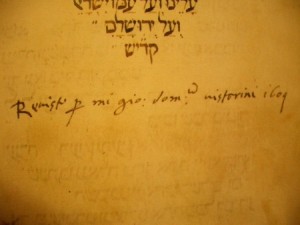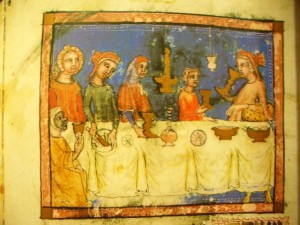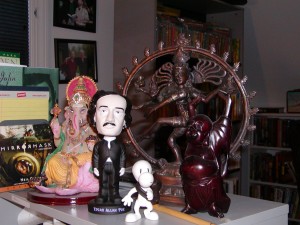Friday, November 28: Bandersnatches
STORIES OF NOVEL WRITING
by Steve Steinbock
It’s getting very near the end of NaNoWriMo (National Novel Writing Month), and I confess, I didn’t do much with it the last ten days or so. It isn’t that I ran out of steam – although to an extent, I did. Rather, I found that just as I was hitting a plot-wall, along came a deadline that required much of my attention.
The plot-wall that I hit involved the crime at the heart of the novel I was writing. The murder and the underlying crime that triggered it no longer gelled with the story that was evolving on the page. I realized that I had to rethink some of the basic events and characters before I could go on. I didn’t stop completely. While the plot was in flux, I took the opportunity to explore the characters a little more by writing whole chapters of dialogue, scenes that may or may not make it into a final novel, which gave me a chance to get to know my characters.
I also wrote a chapter in which I took two of my characters on a long walk. This was set a year or two after the action of the novel, and the two discussed the events of the novel as they remembered it. This gave me a chance to let them talk. Interestingly, the two of them remembered things differently.
Now that the deadline has passed and my project completed, I’m taking some time to look at the plot and the basic premises of the book. I’ll let you know as things develop.
Novels of Stories
I just finished reading a magnificent book that was essentially made up of short stories. While not a mystery, per se, I thought I’d use this forum to tell you about it.
 The book is People of the Book by Geraldine Brooks. She explores the real-life Sarajevo Haggadah – an illuminated Hebrew codex from fourteenth century Spain – and fictionalizes its history using the findings of a rare book conservator as her springboard.
The book is People of the Book by Geraldine Brooks. She explores the real-life Sarajevo Haggadah – an illuminated Hebrew codex from fourteenth century Spain – and fictionalizes its history using the findings of a rare book conservator as her springboard.
The heroine, Hanna Heath, is a bristly thirtyish Australian with a Type-A personality and a lousy relationship with her Type-A mother. Hired by the United Nations in 1996 to prepare the manuscript for display, at a time when the rubble of war is just settling in Boznia-Herzogovina, Hanna finds a series of anomalies: a white hair, an unusual wine stain, a fragment of an insect wing, a salt crystal, and a groove along the parchment pages.
Brooks then takes the reader back in time, telling stories set in WWII Sarajevo, 1894 Vienna, 1609 Venice, and Spain in 1492 and 1480 where we have the benefit of seeing how each of these artifacts fit into the history of the Haggadah.
 While Brooks’ account is a work of fiction, she based much of it on actual details of the Sarajevo Haggadah, including the Muslim librarian who hid it from the Nazis. She also uses fiction to account for some of the real-life anomalies of the book: a mysterious inscription on one of the pages: Revisto per mi. Gio. Domenico Vistorini, 1609, elaborate illustrations anachronistic for Hebrew manuscripts of the time, and the presence of an African female in one of the illustrations (depicting a Passover seder).
While Brooks’ account is a work of fiction, she based much of it on actual details of the Sarajevo Haggadah, including the Muslim librarian who hid it from the Nazis. She also uses fiction to account for some of the real-life anomalies of the book: a mysterious inscription on one of the pages: Revisto per mi. Gio. Domenico Vistorini, 1609, elaborate illustrations anachronistic for Hebrew manuscripts of the time, and the presence of an African female in one of the illustrations (depicting a Passover seder).
This book about a book is highly recommended by your Friday columnist.
Household Gods
Since describing my surroundings (i.e. the clutter around my desk) to you last week, my attention has been drawn to a couple of muses I have perched on my shelves. I mentioned them before, but I’ll use what space I have left today to tell you what they’re doing on my shelves.
People who know me know that I’m a pretty religious guy. I love my religion and I know the Bible better than most. People who know me really well know that I can be pretty irreverent, as well. Some of my favorite parts of the Bible are the R-rated stories. I can point out Biblical puns, jokes, and wordplay in several different languages. And while I’m what most would call a “believer,” I also carry a healthy skepticism.
That may explain, in part, the presence of various pagan figures on my shelves. Since last week’s column, I’ve relocated some of them so they’re now right beside my computer monitor, monitoring my every keystroke. Allow me to introduce them to you:
Shiva (the bronze guy in the middle) is one of the most important Hindu deities. A god of destruction and creation, he is known for dancing the world into and out of existence. As I writer, I can appreciate the importance of the creative dance. Shiva reminds me that I have to keep moving, and keep several balls in the air at once. This statue has four arms, but Shiva is sometimes depicted with as many as eight arms. Imagine how fast he can type.
Ganesha is the Hindu god with the elephant head. According to one myth, he was born out of Shiva’s laughter. Ganesha (whose name is pronounced “Ganesh” by most Hindus) is considered to be the Lord of letters and learning. Very important to us writers. In addition, Ganesha is worshiped as a remover of obstacles. (Can anyone say “writer’s block?”) But to me, most importantly, I just think Ganesha is cool.
Laughing Buddha (the wooden guy to the right). Known in Chinese as Budai Luohan, this guy a symbol of prosperity and success. And he’s always laughing. He is often depicted carrying a bag that is always full, so I see him as a prolific source of ideas. Plus, he reminds me that the act of writing should always be fun, and a little humor never hurts any story.
Uncle Edgar (the guy with the big, wobbly head). Well, duh. He’s the man! Although a brilliantly witty wordsmith who wrote great satire and humor, he’s known mostly for his sad, melancholy, and macabre stories and poems. With his Dupin stories, he defined our genre. And what exactly happened to him during his final days on earth, anyway?
Bone (the cute little white guy with the big nose). Okay, he’s just a comic book character. But he’s cute, cuddly, and he carries a copy of Moby Dick in his satchel. (Am I the only one who enjoyed reading Moby Dick in school?)
By the way, that’s a Chinese calligraphy brush resting in front of the Laughing Buddha. It’s been sitting there for month – long before I put the other icons there. It might have a symbolic meaning, too. But I just didn’t feel like moving it. In the background, against the wall, that’s a photo of me and Ed McBain in his back yard.
Stop on by, and I’ll buy you a cup of coffee and give you a tour of the rest of my office.
Gotta go.




















